Library News
Over 4300 items added to Booth’s collections in April
Posted on May 15th, 2025
Booth Library’s collections are continually growing to meet the research and information needs of the EIU community. Last month, Booth Library acquired and cataloged 100 physical items (books, DVDs, government documents, archival resources, and more) and 4290 electronic resources (including ebooks, ejournals, digital audiobooks, and streaming videos). Individual issues of current periodicals are excluded. All items are discoverable through the library’s online catalog.
New acquisitions include items selected for purchase by Booth’s subject librarians, donations, re-cataloged library items, freely available government publications, and consortium-wide purchases.
Please contact your subject librarian with any questions.
‘A picture is worth a thousand words’
Posted on March 24th, 2023

By Madeline Steiner
University Archives Intern
Among the University Archives at Booth Library are numerous collections of historical documents, objects, and photos – items that carry so much historical information and significance. One such collection is that of Eastern’s all-class photographs, “all-class” meaning everyone involved in the school, including professors, students freshman through senior, and, in most cases, the lab school students, as well.
Today, it sounds like a pretty daunting task just to get one whole class into the same photo, let alone the entire school; however, the collection is a small one, including six panoramic photographs from the late 1910s into the early 1920s, when the class sizes were much smaller. Eastern opened its doors to students on Sept. 12, 1899, with a starting faculty of 18 and with around 125 students. As the years went on, the numbers grew and were up to around 450 in the 1919 school year and in 1924, students, faculty, and lab school students made equaled about 600, which was still rather manageable for a photograph.
Item #1 in the collection is not dated but is from around the late 1910s into the early 1920s, notable by the fact that the school is still titled Eastern Illinois State Normal School, which was Eastern’s name upon being approved in 1895. The name then changed in 1921 to Eastern Illinois State Teachers College. This change can be noted through the timeline created by the photos.
Item #4 was taken March 31, 1921, near the end of the school’s time as Eastern Illinois State Normal School. Item #3 was taken Dec. 8, 1921, and is titled Eastern Illinois State Teachers College. The name change was made between March and December in 1921. Item #4 is also not dated on the physical photograph but can be found in the school’s 1921 edition of the Warbler (they used to print fairly detailed schedules of the entire year in the Warbler), which also includes numerous photos of classes, faculty, and campus.
Of the six photographs, five were taken by Kansas City, Missouri photographer Verne O. Williams, who was evidently well-versed in panoramic photographs. His 1917 Camp Funston series is proof of this. The seven panoramic style photos document the year of construction on Fort Riley’s Camp Funston in Kansas, including construction progress of the entire camp, staff members, and even the crowds of the 1917 football game against the University of Illinois.
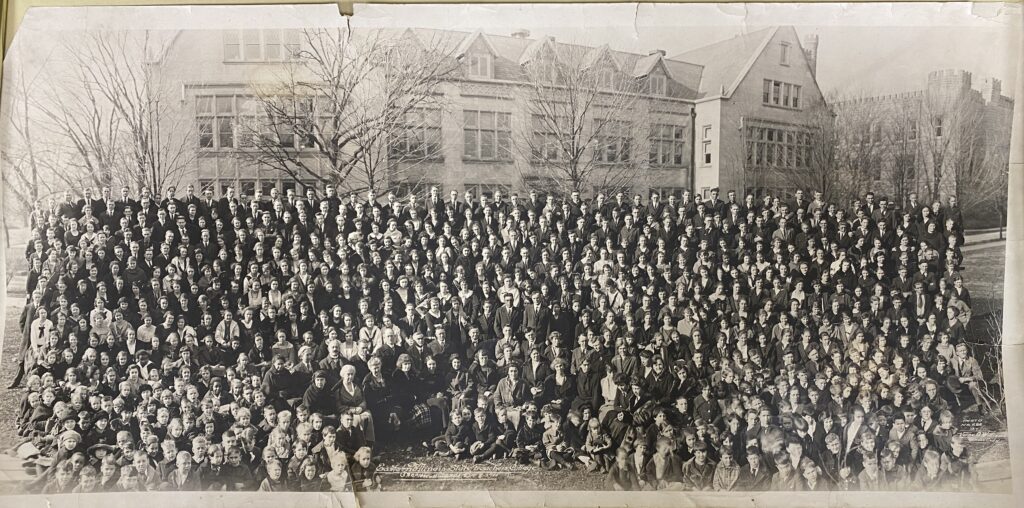
The panoramic photo was quick to be experimented with upon the invention of the camera in 1839. Early panoramas were produced by placing two or more daguerreotype panels (the first commercialized photographic process) next to each other and they began appearing as early as 1851. Because of the desire for panoramic photos, in the late 19th century, cameras were mass produced specifically for panoramas.
The first mass-produced American panoramic camera was in 1898. These mass-produced cameras were easy to develop but could only create small panoramas that could be no longer than 12 inches and only had a field of vision of about 180 degrees, so, in 1904, the Cirkut Camera was patented. This panoramic camera was capable of producing a 360 degree photograph measuring up to 20 feet long. We can infer from the Eastern Illinois prints that Williams might have used a Cirkut Camera because these cameras were commonly used for group photographs and landscapes. Plus, every photo in the collection is well over 12 inches long, with the shortest in length being 32 inches and the longest at 46 inches.
Studying these photos could easily lead the researcher down a rabbit hole of information about Eastern’s past. For example, most of us probably know that Pemberton is one of the oldest buildings on campus, but the greenhouse seen in one of the collection’s photos was the second oldest structure, next to Old Main. Built in 1902, it was designed to provide decorative greenery for the main building. This greenhouse can be seen in the oldest of the collection’s photos, which was taken behind Old Main, in just about the middle of what would be the North Quad today.
Pemberton, only barely noticeable in the same photo, was the third building approved in 1907 and named after Senator and Eastern supporter Stanton C. Pemberton in 1909. Built as an all-female dorm, it was Illinois’s first college dormitory built for the purpose of creating a real campus community. Lord “wanted it to be more than a boarding house; he wanted to provide a family atmosphere for the students” (Otta, 58). Because it was the first of its kind in Illinois, it took a lot of work on the part of President Lord and Senator Pemberton, but it was finally approved, along with a “cracker box” gymnasium, in 1907 and was formally opened in January of 1909.
Blair Hall, seen behind students and faculty in photograph #3, was the fourth building on campus. Blair, originally named the Training School Building, was built for the purpose of training future teachers through the Model School, which was moved there upon the building’s completion in 1913. Later it was referred to as the “lab” school, and was attended by the children of Charleston as well as university faculty. The Training School Building was renamed Blair Hall in 1958.
The details of history can be found anywhere if you look hard enough and do the research. The 1920s all-class photo collection is just one example of many that packs so much information into a few images.
Madeline Steiner is a senior majoring in English from Lincoln, Illinois.
Works Cited
“Barnhart, Terry. “That ‘Noble Project:’ The Founding of Eastern Illinois University and the Origins of Old Main, 1895-1899.” Eastern Illinois University, https://www.eiu.edu/localite/oldmainnobleproject.php. Accessed 24 Feb. 2023.
“A Brief History of Panoramic Photography.” Library of Congress, https://www.loc.gov/collections/panoramic-photographs/articles-and-essays/a-brief-history-of-panoramic-photography/. Accessed 3 Mar. 2023.
Eastern Illinois University, “1918-1968 Warbler: ‘On the Road to Somewhere,’” 1968. The Warbler, 2. http://thekeep.eiu.edu/warbler/2.
Otta Sherri, “Still Going Strong,” 1990. The Warbler, 63, p58-59. http://thekeep.eiu.edu/warbler/6.
Williams, Verne O. and Charles A. Stead. Camp Funston, Fort Riley, Kansas. 25 Jul. 1917, Kansas Historical Society, https://www.kshs.org/archives/218831.
—. Camp Funston, Fort Riley, Kansas. 29 Aug. 1917, Kansas Historical Society, https://www.kshs.org/archives/218834.
—. Camp Funston, Fort Riley, Kansas. 19 Sep. 1917, Kansas Historical Society, https://www.kshs.org/archives/218840.
—. Camp Funston, 14th National Army Cantonment, Fort Riley, Kansas. 1917, Kansas Historical Society, https://www.kshs.org/archives/226933.
—. Engineers, Sanitary Train, Fort Riley, Kansas. 28 Sep. 1917, Kansas Historical Society, https://www.kshs.org/archives/226891.
—. Field Auditor’s Staff, 14th National Cantonment, Camp Funston, Fort Riley, Kansas. 3 Oct. 1917, Kansas Historical Society, https://www.kshs.org/archives/226887.
—. Football Crowd at Camp Funston, Fort Riley, Kansas, Thanksgiving Day. 29 Nov. 1917, Kansas Historical Society, https://www.kshs.org/archives/226921.
Study success kits available on 4th floor
Posted on March 3rd, 2023
A study session goes much better when you are relaxed, focused, and feeling good about yourself. Booth Study Success kits have items to help students get in the right frame of mind to do their best work.
Affirmation cards give you scripts for positive self-talk. Fidget toys can help burn off anxious energy. Timers offer a soothing visual experience and a way to time a break in your study session.
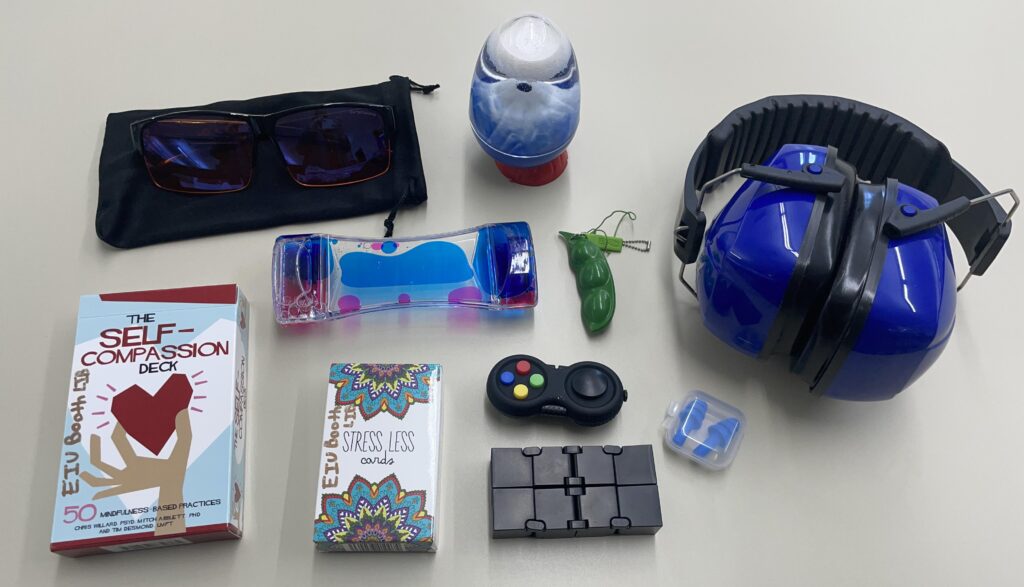
Do fluorescent lights or screen glare leave you feeling overwhelmed? Block the blue light wavelength with the blue-blocking glasses in the kit. If it’s the noise rather than the light that is a distraction, we also offer ear muffs, ear plugs, and a white noise machine.
Feeling ungrounded and floaty? Borrow the weighted blanket for some calming coziness.
All items are available at the Library Technology Services counter on the fourth floor. Kits are available for checkout for one day. The earmuffs, sound machine and blanket must be used in the library. The ear plugs are yours to keep.
The future of postcards
Posted on November 28th, 2022
The EIU Archives has a catalogue of thousands of old and new postcards from around Illinois, the United States, and the world that can provide insight into history, art, and culture not seen elsewhere. You can access many of them through the Booth Library online database, but to see the complete collection, one must come to the Archives in person.
By: Chloe S. Guiliani, EIU English major and senior
The 150th anniversary of American-made postcards is coming up on May 13, 2023, but the Golden Age of postcards are long behind us, ending over 100 years ago in 1915. Over the decades since, postcards have slowly fallen out as a popular form of correspondence. [1][2]
According to a 2017 article by Jeanette Settembre on the Market Watch website, with the rise of the Millennial generation and continued technological advancements, postcards have been cast to the wayside in favor of more convenient, instant communication. Historic postcard-publishing companies are shuttering, if they haven’t already; England’s oldest postcard publisher, J Salmon, halted their printing in 2017 and sold what remained of their stockpile throughout 2018. “Just 25 years ago more than 20 million postcards were sold each year, but now the number has dipped down to just five or six million.” [3]
With the prevalence of social media and reduction in the deliveries of physical mail that people receive each day, people today do not need to rely on postcards to communicate quickly or to capture vistas. Instead, we can easily take our own pictures and selfies on our mobile devices and choose whether to post them online, send them via text or email, or print them out. We can even edit and design our photos to look like a classic postcard, if we wish.
Plugging the term “postcard” into Google Trends will present you with the following graph, which seems to mark the slow downfall of the postcard in the digital age. According to Google Trends, which can track internet search terms from January 2004 to the present, the term “postcard,” to this day, has never reached the peak level of American web searches as it did in February 2004, with an interest value of 100. Currently, in November 2022, the interest value of “postcard” is only 24, which means that American searches for that term are down by 76% from its peak figure nearly 19 years ago. The interest value numbers look even worse for postcards when taking the Google Trends search worldwide, where the peak value of 100 was in December 2004 and is now only 5.
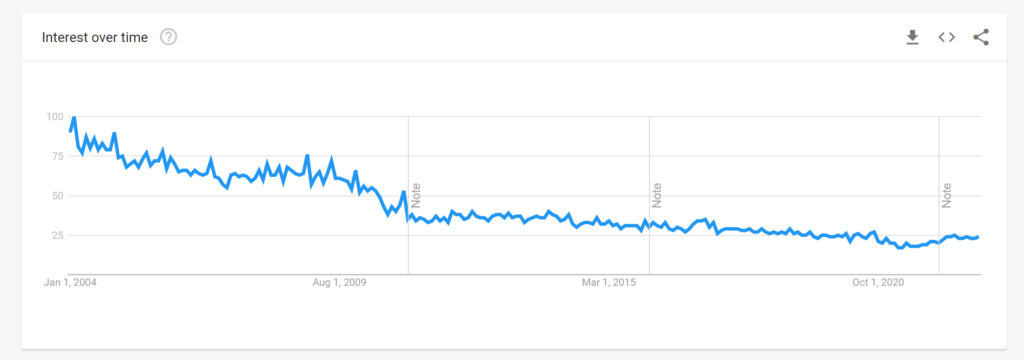
What then, does the future of the postcard look like outside the museum or archives? Do you remember the last time you received a postcard in the mail?
As a business, things don’t look bright, but the interpersonal exchange of pictures and short correspondence has not stopped. Looking to American-focused Google Trends again, it took only one year after the initial launch of the Facebook program in February 2004 for it to be searched for online more than postcards; the exact same can be said for Instagram, launched in October 2010.
Texting through SMS and MMS messaging has also exploded on the mobile market. In 2022, research points to 18.7 billion SMS and MMS messages being sent worldwide each and every day, which is a 7,700% increase in the number of texts sent over the past ten years. [5]
While the quick exchange of images and information will continue to grow and evolve, postcards as a medium to do so seem to slowly be going extinct, and if that is so, it will take archivists, researchers, historians, and collectors to preserve them as a flashpoint in the history of written communications.
Author’s Note: Chloe S. Guiliani is completing an internship this semester in the Booth Library University Archives and Special Collections.
Works Cited
- A History of Postcards. (n.d.). Seneca County, New York – The County Between the Lakes. https://www.co.seneca.ny.us/wp-content/uploads/2020/01/Postcards-History-ADA.pdf
- Kentic, J. (n.d.). How Many Texts Are Sent Per Day? Modern Gentlemen. https://moderngentlemen.net/how-many-texts-are-sent-per-day/
- Postcard Collection – Essay, Appendix C: Manuscripts and Special Collections: NYS Library. (n.d.). Home Page: NYS Library. https://www.nysl.nysed.gov/msscfa/qc16510ess.htm
- Postcard – Explore – Google Trends
- Settembre, J. (2017, September 30). Postcards are becoming extinct and 5 other industries millennials are killing. MarketWatch. https://www.marketwatch.com/story/postcards-are-becoming-extinct-and-5-other-industries-millennials-are-killing-2017-09-30
My favorite postcard at the EIU Archives
By: Chloe S. Guiliani, EIU English major and senior
In all of my work at the EIU Archives, I hadn’t seen night-time views or inclement weather displayed on any of the postcards to which I was assigned. The views were predominantly of the daytime, where clear and sunny skies could lend to the design by lighting certain areas and casting shadows off objects or buildings. And even when it was obvious that the postcard displayed a winter view, the snow and barren trees were always picturesque and peaceful.
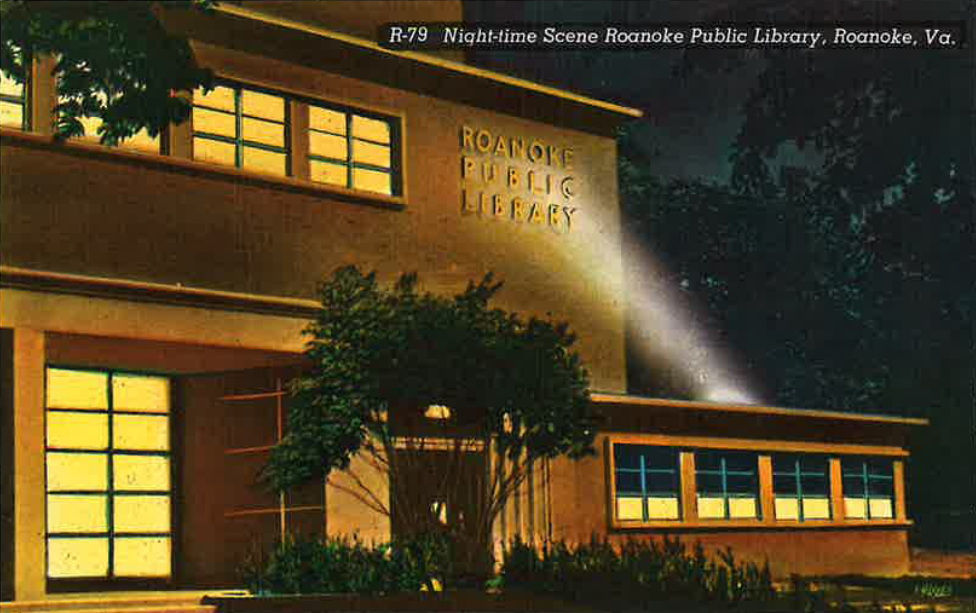
When I thought back on postcards I had seen in my own travels, I couldn’t think of any that stood out for weather or lighting reasons. Idealism is usually at the forefront of postcard design, since potential buyers are more likely to want postcards that capture “the best” an area or view can offer (and not necessarily what it looks like on the average day).
What first caught my attention with this card, in particular, was that it was a night-time view, but it wasn’t what kept me engaged. It seemed so low key compared to the “look at me, look at me” nature of most postcards. At the time of discovering this card in the archival collection, I was working on a project about “Lo-Fi” art, from audio and music to visual works, and what makes something “low fidelity.” Looking at the postcard, I thought to myself, “This has to be the first and only postcard I’ve ever seen that is a Lo-Fi artwork!”
It seemed as though the essence of the postcard was a typical view one might have of the library at night while walking on the sidewalk. It’s a very warm and inviting image, and as an English major, it makes me feel like there’s more of a story here. Just as a postcard might segue a person into reminiscing on an experience, the image pictured on this postcard made me think, “What happens next? What is the story behind this setting?”
And as someone with a knack for detail, there are certain efforts I see in this postcard that I have not seen in many (if any) others. From the way the light shines realistically on the “Roanoke Public Library” sign and doesn’t encompass every letter of it with brightness; or the way the foliage blocks the direct view of the door and matches the background foliage’s lighting technique, making the library feel surrounded by greenery (and it actually is, being situated in a city park).
I was also fascinated at how such a simply designed postcard could make the foliage look so well at night and highlight the silhouette of the background’s canopy, which contrasts with the subtly shaded night sky. Not only does the slight change in tint around the trees make the border between sky and tree more clearly visible, but it gives depth to the small amount of outer space depicted, and it shows that the rest of town is lit up, too (if we could only see past the foliage).
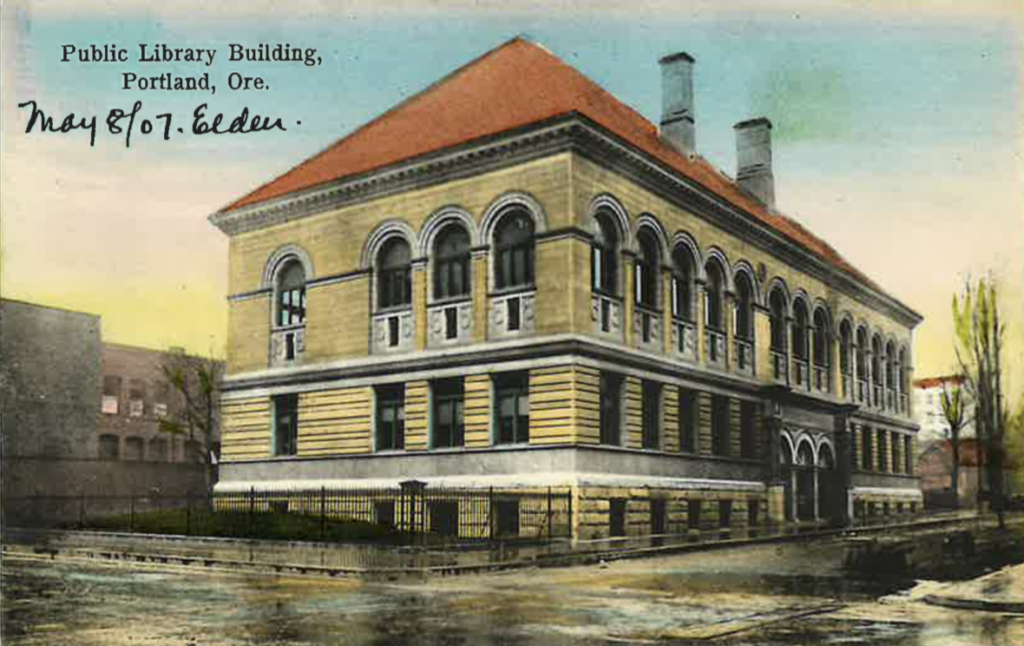
My runner-up for favorite postcard was a library view from Portland, Oregon. First, there are no other postcards that I have seen with such a watery sheen on the ground. In the design, one can also notice that the background is a rough U-shape of out-of-focus skyline, and that the actual focus of the foreground isn’t just the library building but the condition of the road in front of it. Considering the fact that Portland is a city with the third-most rain/snowfall in the entire United States, it only makes sense to not only have postcards with rain in them, but make that rain just as beautiful or omnipresent as it actually can be.
Author’s Note: Chloe S. Guiliani is completing an internship this semester in the Booth Library University Archives and Special Collections.
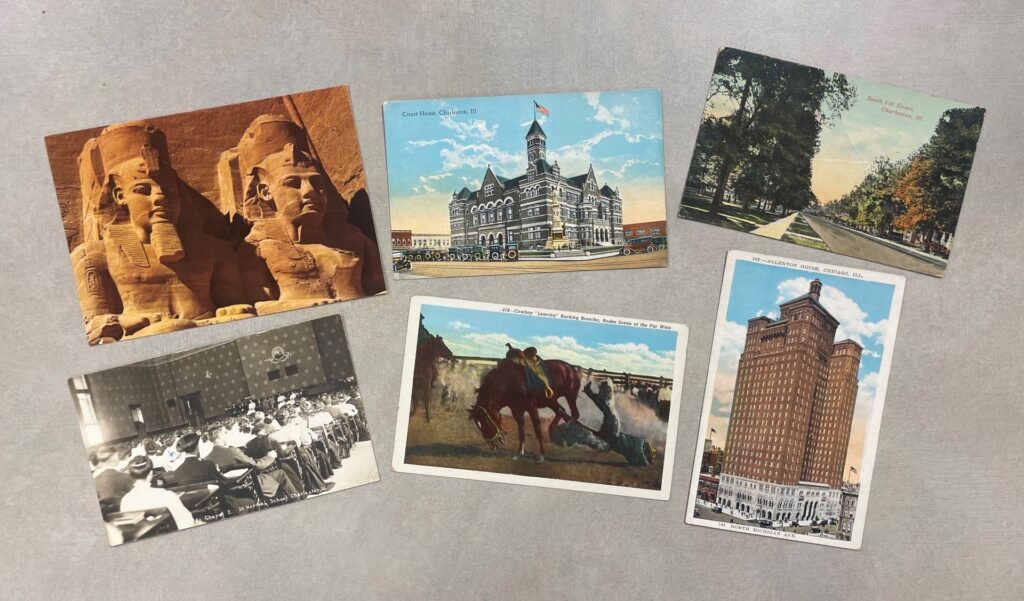
The craze of postcards: How they connect modern times to our shared past
By: Chloe S. Guiliani, EIU English major and senior
It may not seem that important to understand the origins of the postcard and picture-postcard, but postcards and their history not only give you an idea of what something looked like at a given time in history, but the history of human communication, the marketplace of ideas, and cultural exchange. In 1905, the Nottingham Sun was quoted in their report that postcards were “strengthening the bonds of international as well as individual friendship.”
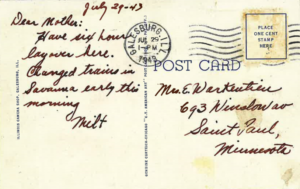
They originated in the mid-to late 1800s, the time where the world was opening up due to the industrial revolution, and so, for the first time, people were able to send and receive messages and pictures from around the planet for as low as half the price of mailing letters in an envelope. For the people of that time, postcards acted like our modern texting, whereas letters would represent a phone call.
In fact, it was the opinion of many in that time that postcards would “ruin society,” whether they had pictures on them or not, just as we hear today about the linguistic effects — good or bad — that could come from texting or internet lingo becoming so commonplace. They argued then that with the limited space on a postcard, the result would be the ruination of polite conversation.
In addition, since most postcards weren’t in an envelope, they would lead to invasions of privacy amongst the population. This is still a topic at the forefront of much of society today, especially involving the privacy-encroachment that internet connection and social media bring us.
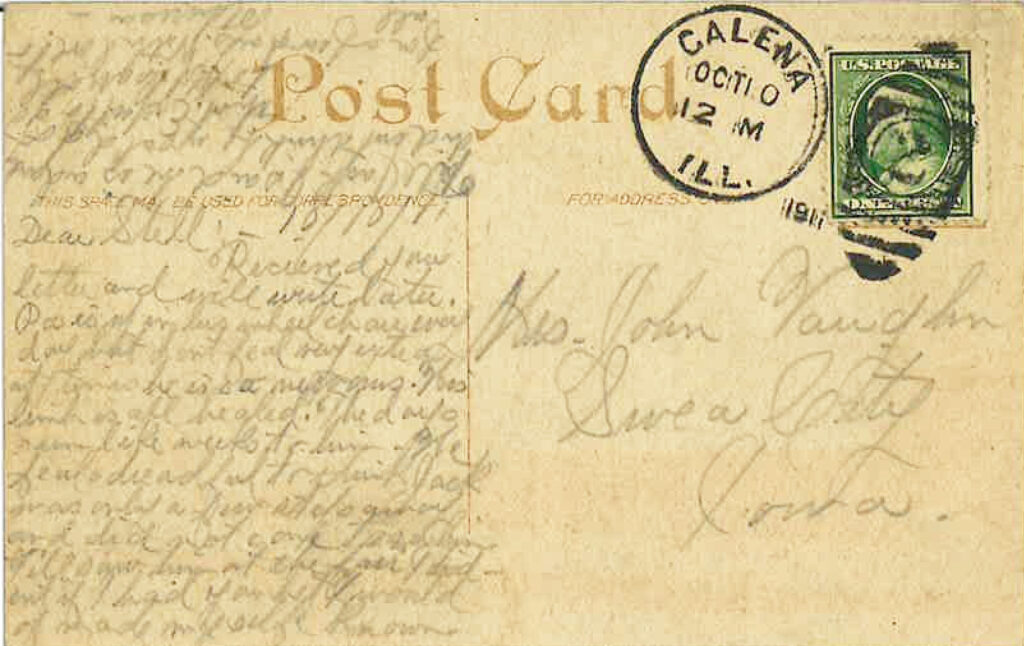
Though the picture postcard wouldn’t become a staple or craze until around the turn of the 20th century, advertisers had been inspired in the early 1870s to use postcards as “open announcements.” They were first restricted to written announcements, but the picture-variety arrived shortly after.
Impetus for the picture postcard grew at the Paris Exhibition of 1889, where the Eiffel Tower — just recently completed — acted as a major attraction for France. There, visitors could not only go up the Eiffel Tower but buy a postcard with its printed image and post it directly from the top of the tower. This trend caught fire and started the entire “postcard craze,” which spanned around the world from Paris to Vienna and the United States to Imperial Japan.
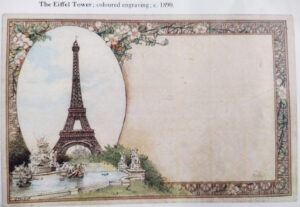
Subsequently, postcards became a hot item, and you could buy and post at the summit of whatever tower, lighthouse, road, or big and notable hill you happened to find yourself. Postcards were a quick and cheap way for our recent ancestors to capture and share an experience, and prove they’d done or seen it, whatever it may be, just as we modern people might make a social media post of a landscape or a selfie of ourselves whenever we happen to climb a mountain, reach a scenic overlook, or make it out of the grocery store in less than 15 minutes.
It might seem odd, but even the postmark over the stamp mattered, since it proved where and when you had sent the card from exactly, and collectors wanted it to match the location pictured on the card. This mattered so much, in fact, that many folks posted their cards to themselves. Not only that, but in France, you could take cards you never actually posted into the post office just to receive that valuable postmark, if only to get that gratifying feeling and prevent postmark FOMO. These historical “social media location filters” were valuable, not only to hobbyists and collectors then but collectors and historians now.
The entry to the EIU Archives is located inside the south atrium of Booth Library, by the clock tower. The 1972 second-edition Pictures in the Post: The Story of the Picture Postcard and its Place in the History of Popular Art by Richard Carline is available for checkout at Booth Library.
Works Cited
- Carline, R. (1972) Pictures in the Post: The Story of the Picture Postcard and its Place in the History of Popular Art. 2nd Edition. Philadelphia , PA: Deltiologists of America.
Author note: Chloe S. Guiliani is completing an internship this semester in the Booth Library University Archives and Special Collections.
MLA Handbook Plus is available
Posted on December 15th, 2021
The popular MLA Handbook is newly available in electronic form, and Booth Library has a subscription for campus-wide use (including off-campus access for EIU users).
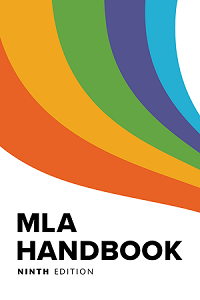
MLA Handbook Plus contains the complete text of the 9th edition (2021) of the handbook, which provides guidance on writing research papers and citing sources using MLA Style. Please contact your subject librarian with any questions on this database.
Database trial to Accessible Archives collections
Posted on October 27th, 2021

Booth Library has begun a trial to the full suite of primary source digital collections from Accessible Archives. Through this trial, which runs through November 30, users will be able to view and search many historical databases to which we don’t currently subscribe, including:
The AMAROC News: America’s Occupation of the Rhineland, 1919-1923
America and World War I: American Military Camp Newspapers
American County Histories
Anatomy of Protest in America Series
Invention and Technology in America
Quarantine and Infectious Disease Control: Books and Newspapers
Woman Suffrage Collection
See the Accessible Archives collections page for a complete list and an introductory video. Please contact your subject librarian with any feedback or questions!
Inclusive excellence: Booth highlights resources for Jewish Book Month
Posted on October 27th, 2021
Booth Library has an in-depth collection of resources focusing on cultural acceptance and inclusivity. During 2021, our librarians are featuring research guides on a variety of these topics.
In our latest guide, we focus on resources for Jewish Book Month, a celebration of books on Jewish topics that takes place over the thirty days prior to Chanukah. Our selection includes books in the areas of art, history, biography, religion, the Yiddish language, women’s lives, literature, and more.
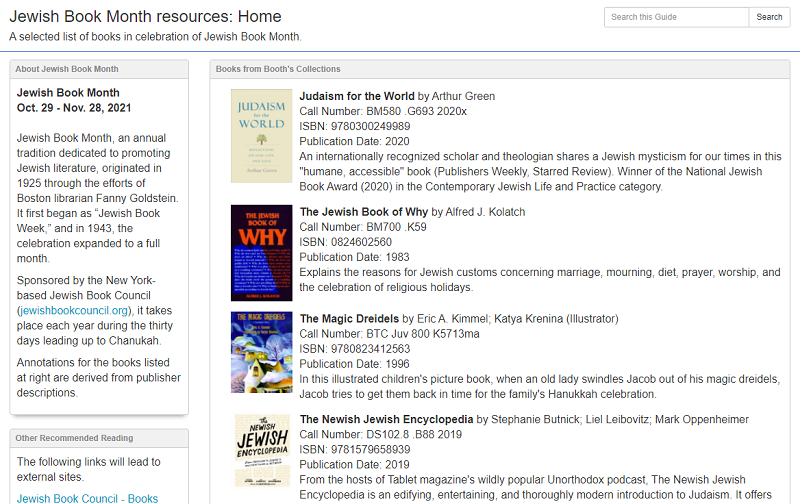
Inclusive excellence: Library highlights materials for Latino Heritage Month
Posted on September 22nd, 2021
Booth Library has an in-depth collection of resources focusing on cultural acceptance and inclusivity. During 2021, our librarians are featuring research guides on a variety of these topics.
This month, we focus on materials related to Latino Heritage Month, which is celebrated on the EIU campus through Nov. 2. Several activities are planned.
Please see our guide with search tips to find materials on a variety of specific topics.
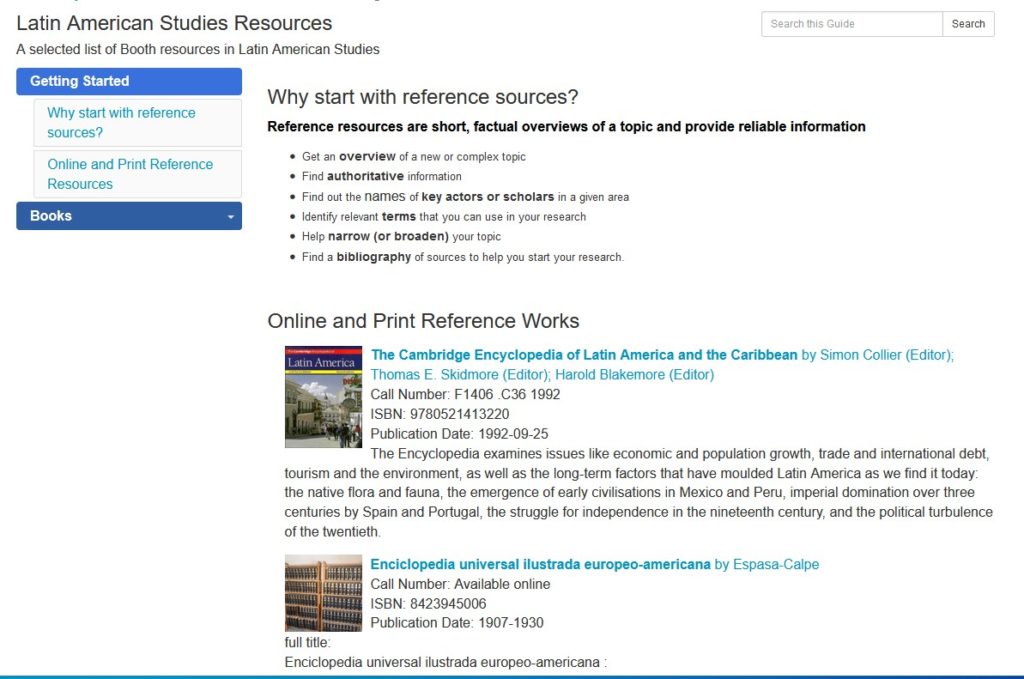
Learn piano or guitar: For beginners to the professional musician
Posted on September 22nd, 2021
You know the library has books and DVDs and CDs and streaming movies and electronic media of all kinds. You know we have information professionals (aka librarians) available to support your educational and research needs. You know Booth Library has beautiful spaces and comfortable places to work and relax, you may even know about the technology newly available to support your digital projects in the Center for Student Innovation.
But did you know you can use Booth Library spaces and equipment to become a musician or expand your repertoire?
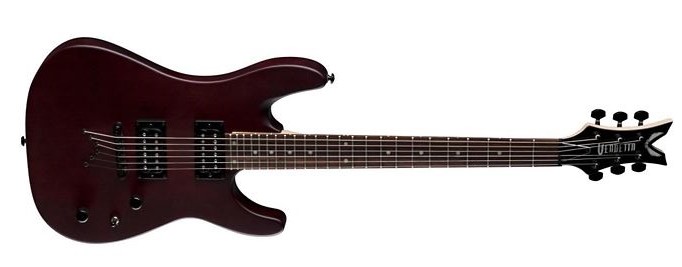
It’s true! Booth library has electric guitars (Dean Vendetta hardtail) available for use in the rehearsal rooms on the 4000 level of the library. Rehearsal rooms are equipped with amplifier emulation software offering the sound of 64 amplifiers, 77 speaker cabinets and 113 effects. The available software includes Amp Kit, Pod Farm or Guitar Rig. Not only that, but there are two electric guitars available for use outside of the library at the Library Technology Services desk on the 400 level. A headphone amplifier and tuner are checked out with the guitars.
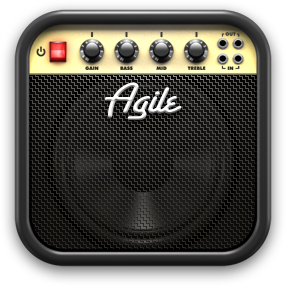
The two rehearsal rooms on the 4000 level are equipped with Yamaha Clavinova CLP 950M digital pianos with weighted keys. The pianos are attached to a computer to allow for multitrack digital recording.
And of course in addition to the equipment and rehearsal space, Librarians at Booth — notably Head of Library Technology Services Stacey Knight Davis and Liaison for Music and Head of Cataloging Bill Schultz — have created excellent research guides to help you find the best learning materials for any level and style you wish to learn. The Piano guide features beginner and adult piano instruction manuals as well as several jazz, rock, Latin and swing piano songbooks. Our catalog will help you find hundreds more.
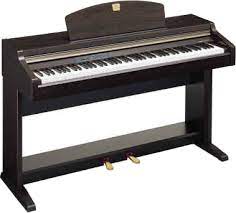
The acoustic, electric and bass guitar guide boasts over 200 books on instruction from beginner to advanced, chords and theory along with dozens of music books on jazz, Latin, classical, rock, bluegrass, country, blues, songbooks and collections of hits from popular artists from the last century. Many come with accompanying CDs or DVDs.
Whether you already play and just want to brush up your chops with some books for home, or you have an interest in self-directed musical study and need the equipment to get started, the faculty and staff at Booth want to help you succeed.
EBSCO Academic Search Ultimate and CINAHL Complete now available
Posted on September 2nd, 2021
Booth Library recently upgraded two of our academic databases from EBSCO to better serve researchers.

Academic Search Ultimate is EBSCO’s largest multi-disciplinary article database, with over 4800 full-text, non-open-access journals, most of which are peer-reviewed, from over 80 countries. It also provides access to a curated collection of over 4000 high-quality open access journals and over 75,000 videos from the Associated Press.

CINAHL Complete is a comprehensive research database for nursing and allied health, with over 1300 full-text journals, most of which are peer-reviewed, and numerous evidence-based care sheets. Booth Library’s version of CINAHL Complete is set up with PICO Search, a form that helps you formulate search strategies for evidence-based practice (Population, Intervention, Comparison, Outcome).
Please ask a librarian for more information or help using these databases.



